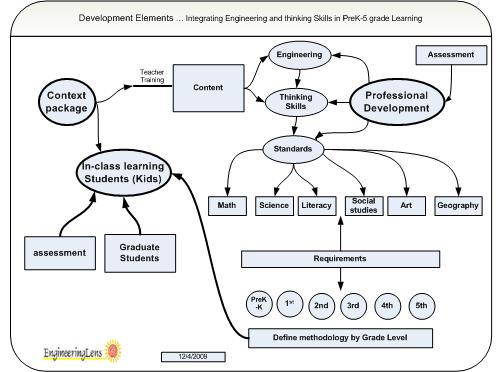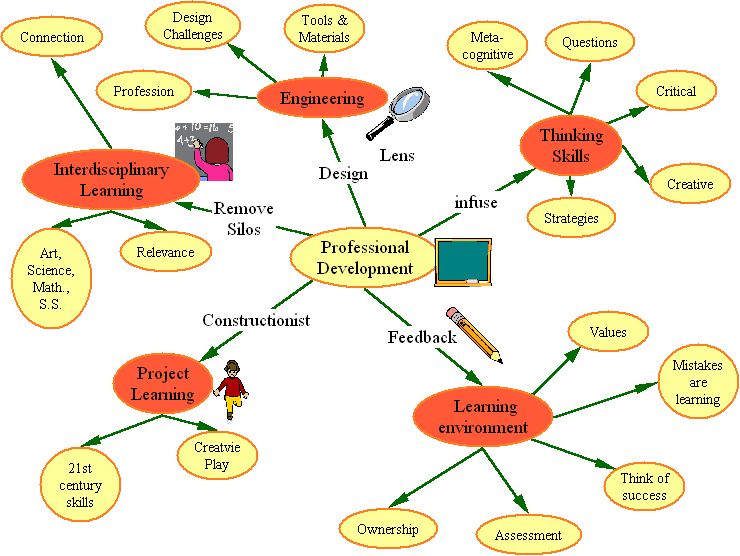|
92109.gif)
Our idea
is to show you how to, in a systematic way, create an
interdisciplinary project learning experiences using the design
process and thinking skills as the connector. Many of you
probably have done projects around literature and other subjects, but
we hope to develop a way that is systematic and provides your
student the ability to participate in the process of finding design
challenges in the stories they are reading. We are
creating a professional development (PD) syllabus that we model for
you the methodology. The major elements of the PD are shown
below. This web site is the work book of templates and
examples for your continuous use.
Shown below is a model for a professional Development
program.
Table of
Content:
Note:
each of the links below open in a separate window in your browser.
 Definitions,
Standards Definitions,
Standards
As in any new system, definitions and standard to be used need to be
identified and explained. These vocabulary words can be used
as part of the learning spiral of your students.
Definitions:
Find the definitions of word that are
used in this work book.
Standards:
When creating interdisciplinary learning
projects around stories, the
Massachusetts State Standards need to be known and integrated in
the learning experience.
 Goal
setting for feedback and rubrics Goal
setting for feedback and rubrics
The success of this concept relies on
the students to be part owners of their learning, they must share in
developing the measurement system to be used. Design with the
students
how
are we going to measure success and provide feedback during
this activity.
 About
Engineering
... Scientists and Mathematicians About
Engineering
... Scientists and Mathematicians
We need to understand
what an engineer does to be able to understand the
Strand 4 of the Science Framework and create these
interdisciplinary learning projects. Teachers are the
engineers of learning and must see that they
know more about engineering then they think.
This needs to be
modeled to our students
so they also can
see the relevance of the learning process and the specific
subjects.
The essential question is
"Why do I need to know about engineering as an educator?"
 Design process Design process
The
design
process is at the heart of this methodology. We use the
definition of engineering as designing useful products or processes
for society based on all disciples, but mainly math and science.
 How to Connect Stories How to Connect Stories
We begin to enhance the
learning process by using the engineering design methodology as a
connector between literature, science & mathematics. Within this
process is an infusion of thinking skill strategies, such as
creative and critical thinking, questions and meta-cognitive
reflection. The concept uses the existing comfort level of the
elementary teachers and the student’s natural engineering abilities.
The process begins with literature, such as fairy tales, starting in
the lower grades and leading to more sophisticated stories at older
ages – stories that engage students. The underlining skills of the
engineering design process are related to the science process,
mathematical problem solving (process) and thinking skills. Thus the
student is taught how to think skillfully.
"Engineering design
challenges" are created by actionable items in the story and lead to
inquiry based team projects that have a design theme.
 Examples Examples
 Differences in PreK through 5th
grade. Differences in PreK through 5th
grade.
How do we account for
differences in students over the range
of grades and in some cases within grades. Each of us is
different and come at learning in different ways. We must
understand where our students are coming from and their learning
style and needs.
 Thinking
skills Thinking
skills
We as educators, need to
infuse thinking skills into this
learning process. We like to say that Thinking Skills are one of the
tools of engineers. It is important to model for our students the
use of thinking skills and provide feedback to them on their use.
Creative and critical thinking are key to the finding design
challenges and doing a design. Questioning is needed
through-out the process as well as developing our curiosity.
Meta-cognitive reflection bring in the ability to see what we are
doing and change where necessary and using
( shown in a Goldilocks application)
Blooms higher order taxonomy bring the ability to think about
what we are doing.
 Conclusion/References Conclusion/References
SAMPLES:
-
Design with the
students "How
are we going to measure success and provide feedback during
this activity".
-
Find a design
challenge in the story by using a
story
map.
-
Use of a
mind map
and the probing questions to develop the design challenges.
-
Create the
Design
challenges with a thought to the math and science elements.
-
Group
selection
of the design challenge to work with.
-
Create the
project
groups where the students can collaborate, design and
present their results.
-
Start the
design
process. Students use creative and critical thinking
to research, development and test their solutions.
PD
Implementation Process:
 |
![]()
92109.gif)

